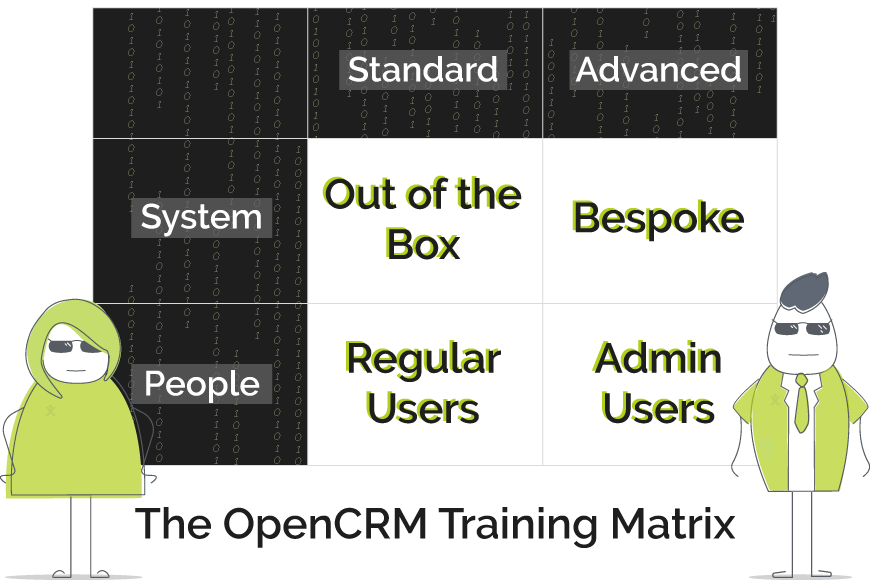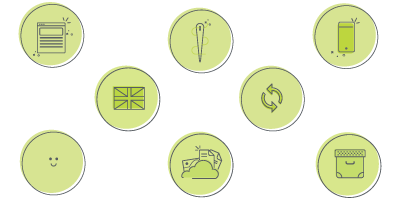Your CRM Training Matrix
29 Apr 2019
Managing the configuration and training for your CRM system is something that deserves careful consideration. In order to help you work out which areas of training you should focus on, we have designed our own CRM Training Matrix.

As the Training Matrix shows, the factors to be considered can be broken down into two areas – the system itself, and the people using it. Both of these areas can be further segmented into standard and advanced configuration and user training.
The system set-up needs to be carefully considered as a first priority, to make sure it is designed to meet your requirements, and the user training can follow on from there. Decisions around the system configuration and training will be about affirming the reasons why you have decided to deploy a CRM system. If it is to address a specific business goal – for example making sure no Lead slips through the net, or to track the number of touchpoints involved with each Opportunity, then you need to review the build to make sure it is designed to help you succeed in those aims.
Configuring Your Out-of-the-Box CRM
Your CRM provider should be able to provide you with a knowledgebase of FAQs and video resources to get you started. All you’ll need to know is how to distill this wealth of knowledge to focus on the features relevant to you.
The documentation will be broken down area by area, so if you are planning to start out by using contact and sales management, you’ll need to look at the guides that tell you how to convert a lead to an opportunity for example.
Additionally a CRM system will be designed with considerable breadth and depth, which is all great but for those of you just starting out on their journey this could result in you being overwhelmed. Therefore most of the standard functionality can be hidden away – note I didn’t say deleted – to make the interface as straightforward as possible for new users. Following the user guides, you can also perform plenty of the configuration on the system yourself – add custom fields, hide other fields, design templates, update picklists, manage user settings and permissions and so on.
Making It Yours – The Bespoke Config
On top of the standard functionality, you may have some requirements that are unique to your company or industry. An examples may be to automate the transfer of data from an in-house piece of software into your CRM. Or you may need some custom reports building, or some bespoke search functionality that goes beyond what the regular system provides.
This is where your project managers and consultants get their heads together with your CRM provider. Essentially you present them with your ideas, and the provider can turn this request into “CRM-speak” and develop the concept in a logical manner. With their inside-out knowledge of the product, they will be able to advise on the best way of achieving what you need, and can liaise with their development team to deliver your bespoke solution in a way that meets your requirements whilst fitting in nicely with what the system already offers.
To accompany the training, the bespoke work should be well documented. As time goes by, people come and go, so it is no good simply relying on one user’s knowledge of how a system functions. This is where you’ll need to build your own internal knowledgebase and configure that intellectual property that is unique to you.

What do you get with OpenCRM?
Unrivalled customer support? 2TB of storage per account? Data held in EU? It's the sort of stuff we think you should be able to take for granted, but which you won't necessarily get from our competitors.
find out moreAdditionally to make the most of the system, you’ll need a two-tiered approach for the people using the system – firstly the ones involved in the back-end management and ongoing maintenance, and secondly the users that will be logging in on a daily basis. Let’s turn our attention to the “people” side of the Training Matrix.
Championing The Cause
These are the users that will be heavily involved in the design, implementation and ongoing system management. They will possess the know-how to translate what your standard users need from the system, into processes that can be configured.
System Management
There are various aspects of the system that will be the admin’s responsibility. This can be from anything to doing back-end system configuration – adding custom fields and generally configuring the system – see part one of the Training Matrix. Once the system is set up there will be a lot of fine-tuning to be done as people get used to working with the new software – designing reports and custom views, setting up permissions and creating dashboards for each department. The key takeaway here is that the system champions they will learn how to manage the system, so their teams gain the most benefit from their CRM.
System Configuration
They will not only need to know how the back-end works, but also how the team on the ground is using the system. You may have a sales team living in the sales cycle on the one side and a support crew embedded in the helpdesk side of things on the other. You’ll need to think about how much information needs to be available to both sides, so they can see what is important to them, without overwhelming them with information.
Whilst we’re on the subject of keeping that information manageable in bite-sized chunks, the same applies when teaching the admins how to do their jobs. There are some good shortcuts available which will definitely make their lives easier. As an example – duplicating reports, views and templates and then making minor changes is better than starting each piece of config from scratch. Whilst some of this may be self-evident, it is worth pointing these short-cuts out in the training session to help get the admins on-board.
Teaching these basics is a significant step towards making the client self-sufficient and will help with the long-term success of the system.
Putting The Wheels In Motion
Once your CRM champions are good to go and the system has been configured, you are in a position to get the final piece of the Training Matrix in place – training your users. When you are ready to roll this out there are a number of things to consider –
Areas of the system
Keep the training relevant. I remember running a training session once and it was clear from the lack of engagement that completely the wrong people were in the room. They were seeing parts of the system that had no relevance to their working day and it was a pointless exercise, for both me as the trainer and for the people sitting around the table.
An important detail is to get the buy-in of the users. People are by and large, resistant to change so you need to sell the idea of the CRM to the team, and get them to understand why you’re promoting this change.
Another key point is to make sure people have scheduled the training time into their day. I’ve had various sessions with sales people where they were getting interrupted by sales calls throughout the day and it really impacted on their attention spans as their mind was on other things.
Level of skill
Are all your users newbies to CRM, or have some of them used the same or similar software before? Do you have entry level team members or apprentices who may be technical, but not as business savvy as other employees?
If you have a varying range of abilities, you may want to break the group down and schedule individual training sessions appropriate to their skillset. If the session is too easy the attendees will get bored and will miss out on the key points that they need to learn, as they will have switched off long before then. Similarly, you don’t want new users to miss out on learning the basics, or they will be in danger of drowning in information well before they have learned to swim.
Timing
There are a few things to consider here – when you’ll schedule the training, and how long do the users need? If you do the training too early – before the bespoke configuration has been completed, or without any data in there – users are not seeing a finished product, nor do they have any relevant information contained that they can get their heads round.
Furthermore, should you do the training months before the software rollout, you will probably end up paying double as you’ll need to run refresher training sessions further down the line.
Think about attention span. It is easy to split the training down into bite-sized sessions of say 90 minutes, which won’t overwhelm your team with too much to take in. Training can pretty much always be delivered via a conference call and a screenshare, so there isn’t always a need to cram everything into one intense full-day’s training.
It is also worth doing a follow-up session a few weeks in, just to make sure people are on the right track, and that the information from the initial session has stuck. This also gives the chance for the users to raise any questions that may have cropped up following the first round of training. They will have time to formulate their questions and can maybe send write down some notes and forward these to the trainer, to ensure they get a carefully considered response. After all there is no real benefit to simply putting your users or indeed the trainer on the spot as they are not likely to put a well thought-out solution together.

Watch and learn
If you're looking for further information on how specific features and functionality play out in OpenCRM, why not click to check out our webinars?
watch nowOne thing the four areas have in common – preparation is the key! Know what you want and work out what you need to do to get there. Paying attention to all aspects of the CRM Training Matrix is the best way to ensure your system is adopted successfully and for the long term.
My role is to build our Customer Success team and I work with our clients and prospects helping them get the most from their subscription – it is a fun challenging role as no two days are the same. When not in the office I’ll be either making a noise on my guitar or getting my trainers on for a run out in the Yorkshire Dales, North York Moors or the Lake District.